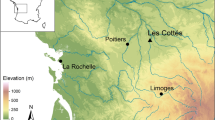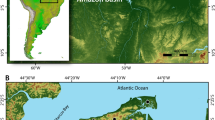Abstract
PLANTS with the C4 dicarboxylic acid pathway of photosynthesis have markedly higher 13C/12C ratios than plants with the C3 or Calvin pathway1–4. Cumulative assessments of relative 13C concentration (δ13C) values for C3 plant foliage yield an average of −26.5‰, relative to the PDB standard whereas C4 plants average −12.5‰ (ref. 5). These differences in carbon isotope ratios are passed along the food chain to animals and man, so that the nature of the plant food base can be determined through measurements on different body tissues of the consumers. In this study, the time of introduction of maize, a C4 plant, to the prehistoric inhabitants of several regions in woodland North America, almost exclusively a C3 plant regime, was determined through isotopic measurements on human bone collagen. The subsequent elevation of maize to the level of a diet staple is also documented.
This is a preview of subscription content, access via your institution
Access options
Subscribe to this journal
Receive 51 print issues and online access
$199.00 per year
only $3.90 per issue
Buy this article
- Purchase on Springer Link
- Instant access to full article PDF
Prices may be subject to local taxes which are calculated during checkout
Similar content being viewed by others
References
Bender, M. M. Radiocarbon 10, 468–72 (1968).
Craig, H. Geochim. cosmochim. Acta 3, 53–92 (1953).
Park, R. & Epstein, S. Geochim. cosmochim. Acta 21, 110–26 (1960).
Smith, B. N. & Epstein, S. Pl. Physiol. 47, 380–84 (1971).
Vogel, J. C., Fuls, A. & Ellis, R. P. S. Afr. J. Sci. 74, 209–215.
Stenhouse, M. J. & Baxter, M. S. Radiocarbon 18, 161–72 (1976).
De Niro, M. J. & Epstein, S. Geochim. cosmochim. Acta 42, 495–506 (1978).
Vogel, J. C. S. Afr. J. Sci. 74, 298–301 (1978).
Vogel, J. C. & Waterbolk, H. T. Radiocarbon 9, 107–55 (1967).
Vogel, J. C. & Waterbolk, H. T. Radiocarbon 14, 6–10 (1972).
Asch, N. B., Ford, R. I. & Asch, D. L. Illinois St. Mus. Rep. No. 24 (1972).
Buikstra, J., thesis, Univ. Chicago (1972).
Featherstone, B. J. Central St. Anthrop. Soc. Cincinnati (1972).
Hemmings, E. T. W. Va Archaeologist 26, 46–58 (1977).
Teeri, J. A. & Stowe, L. G. Oecologia 23, 1–12 (1976).
Zawacki, A. A. & Hausfater, G. Illinois St. Mus. Rep. No. 17 (1969).
Downton, W. J. F. Photosynthetica 9, 96–105 (1975).
Vogel, J. C. & van der Merwe, N. J. Am. Antiq. 42, 238–42 (1977).
Author information
Authors and Affiliations
Rights and permissions
About this article
Cite this article
VAN DER MERWE, N., VOGEL, J. 13C Content of human collagen as a measure of prehistoric diet in woodland North America. Nature 276, 815–816 (1978). https://doi.org/10.1038/276815a0
Received:
Accepted:
Published:
Issue Date:
DOI: https://doi.org/10.1038/276815a0
This article is cited by
-
Biomolecular evidence for changing millet reliance in Late Bronze Age central Germany
Scientific Reports (2024)
-
The Impact of Contact: Isotope Geochemistry Sheds Light on the Lives of Indigenous Australians Living on the Colonial Frontier in Late 19th Century Queensland
Archaeologies (2023)
-
Dietary reconstruction of the Bronze Age necropolis of Cova des Pas (Minorca Island): evidence from δ13C and δ15N analyses
Archaeological and Anthropological Sciences (2023)
Comments
By submitting a comment you agree to abide by our Terms and Community Guidelines. If you find something abusive or that does not comply with our terms or guidelines please flag it as inappropriate.



